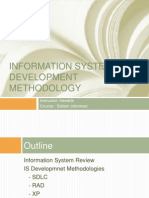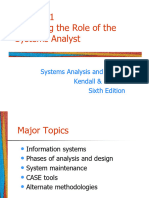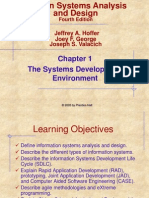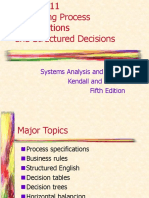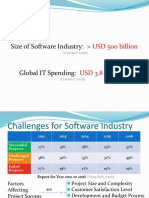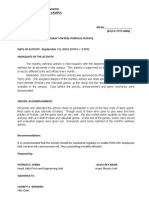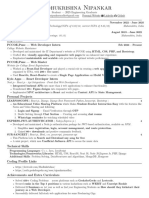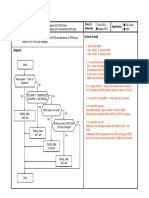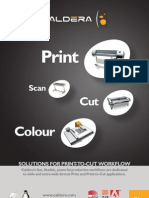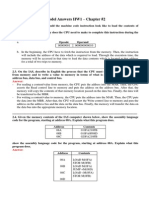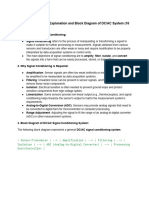0 ratings0% found this document useful (0 votes)
47 viewsAssuming The Role of The Systems Analyst: Information System Analysis and Design Dr. Patrick D. Cerna MSC AICM Program
Assuming The Role of The Systems Analyst: Information System Analysis and Design Dr. Patrick D. Cerna MSC AICM Program
Uploaded by
PatcernaCopyright:
© All Rights Reserved
Available Formats
Download as PDF, TXT or read online from Scribd
Assuming The Role of The Systems Analyst: Information System Analysis and Design Dr. Patrick D. Cerna MSC AICM Program
Assuming The Role of The Systems Analyst: Information System Analysis and Design Dr. Patrick D. Cerna MSC AICM Program
Uploaded by
Patcerna0 ratings0% found this document useful (0 votes)
47 views38 pagesOriginal Title
chapter1_A
Copyright
© © All Rights Reserved
Available Formats
PDF, TXT or read online from Scribd
Share this document
Did you find this document useful?
Is this content inappropriate?
Copyright:
© All Rights Reserved
Available Formats
Download as PDF, TXT or read online from Scribd
Download as pdf or txt
0 ratings0% found this document useful (0 votes)
47 views38 pagesAssuming The Role of The Systems Analyst: Information System Analysis and Design Dr. Patrick D. Cerna MSC AICM Program
Assuming The Role of The Systems Analyst: Information System Analysis and Design Dr. Patrick D. Cerna MSC AICM Program
Uploaded by
PatcernaCopyright:
© All Rights Reserved
Available Formats
Download as PDF, TXT or read online from Scribd
Download as pdf or txt
You are on page 1of 38
Chapter 1
Assuming the Role of the
Systems Analyst
Information System Analysis and Design
Dr. Patrick D. Cerna
Msc AICM Program
Major Topics
Information systems
Phases of analysis and design
System maintenance
CASE tools
Alternate methodologies
Kendall & Kendall Copyright © 2002 by Prentice Hall, Inc. 1-2
Information
Information is an organizational
resource which must be managed as
carefully as other resources
Costs are associated with information
processing
Information processing must be
managed to take full advantage of its
potential
Kendall & Kendall Copyright © 2002 by Prentice Hall, Inc. 1-3
Categories
Information systems fall into one of the
following eight categories:
Transaction processing systems (TPS)
Office automation systems (OAS)
Knowledge work systems (KWS)
Management information systems (MIS)
Decision support systems (DSS)
Expert systems (ES)
Group decision support systems (GDSS)
Executive support systems (EES)
Kendall & Kendall Copyright © 2002 by Prentice Hall, Inc. 1-4
New Technologies
New technologies are being integrated
into traditional systems
Ecommerce uses the Web to perform business
activities
Enterprise Resource Planning (ERP) has the
goal of integrating many different information
systems within the corporation
Wireless and handheld devices, including
mobile commerce (mcommerce)
Open source software
Kendall & Kendall Copyright © 2002 by Prentice Hall, Inc. 1-5
Advantages of Using the Web
Increasing awareness of the availability
of the service, product, industry,
person, or group
24-hour access for users
Standard interface design
Creating a global system
Kendall & Kendall Copyright © 2002 by Prentice Hall, Inc. 1-6
Nature of Analysis and Design
Systems analysis and design is a
systematic approach to identifying
problems, opportunities, and objectives;
analyzing the information flows in
organizations; and designing
computerized information systems to
solve a problem
Kendall & Kendall Copyright © 2002 by Prentice Hall, Inc. 1-7
Systems Analyst
Systems analysts act as
Outside consultants to businesses
Supporting experts within a business
As change agents
Analysts are problem solvers, and
require communication skills
Analysts must be ethical with users and
customers
Kendall & Kendall Copyright © 2002 by Prentice Hall, Inc. 1-8
Systems Development Life
Cycle
The systems development life cycle is a
systematic approach to solving business
problems
It is divided into seven phases
Each phase has unique activities
Kendall & Kendall Copyright © 2002 by Prentice Hall, Inc. 1-9
Phase 1
Identifying
Problems
Opportunities
Objectives
Personnel involved
Analyst
User management
Systems management
Kendall & Kendall Copyright © 2002 by Prentice Hall, Inc. 1-10
Phase 2
Determining information requirements
Interview management, operations
personnel
Gather systems/operating documents
Use questionnaires
Observe the system and personnel
involved
Learn the who, what, where, when, and
how, and the why for each of these
Kendall & Kendall Copyright © 2002 by Prentice Hall, Inc. 1-11
Phase 2
Personnel involved
Analyst
User management
User operations workers
Systems management
Kendall & Kendall Copyright © 2002 by Prentice Hall, Inc. 1-12
Phase 3
Analyzing system needs
Create data flow diagrams
Document procedural logic for data flow
diagram processes
Complete the data dictionary
Make semistructured decisions
Prepare and present the system proposal
Recommend the optimal solution to
management
Kendall & Kendall Copyright © 2002 by Prentice Hall, Inc. 1-13
Phase 3
Personnel involved
Analyst
User management
Systems management
Kendall & Kendall Copyright © 2002 by Prentice Hall, Inc. 1-14
Phase 4
Designing the recommended system
Design the user interface
Design output
Design input
Design system controls
Design files and/or database
Produce program specifications
Produce decision trees or tables
Kendall & Kendall Copyright © 2002 by Prentice Hall, Inc. 1-15
Phase 4
Personnel involved
Analyst
System designer
User management
User operations workers
Systems management
Kendall & Kendall Copyright © 2002 by Prentice Hall, Inc. 1-16
Phase 5
Developing and documenting software
Design computer programs using structure
charts, Nassi-Schneiderman charts, and
pseudocode
Walkthrough program design
Write computer programs
Document software with help files,
procedure manuals, and Web sites with
Frequently Asked Questions
Kendall & Kendall Copyright © 2002 by Prentice Hall, Inc. 1-17
Phase 5
Personnel involved
Analyst
System designer
Programmers
Systems management
Kendall & Kendall Copyright © 2002 by Prentice Hall, Inc. 1-18
Phase 6
Testing and maintaining the system
Test and debug computer programs
Test the computer system
Enhance system
Kendall & Kendall Copyright © 2002 by Prentice Hall, Inc. 1-19
Phase 6
Personnel involved
Analyst
System designer
Programmers
Systems management
Kendall & Kendall Copyright © 2002 by Prentice Hall, Inc. 1-20
Phase 7
Implementing and evaluating the
system
Plan conversion
Train users
Purchase and install new equipment
Convert files
Install system
Review and evaluate system
Kendall & Kendall Copyright © 2002 by Prentice Hall, Inc. 1-21
Phase 7
Personnel involved
Analyst
System designer
Programmers
User management
User operations workers
Systems management
Kendall & Kendall Copyright © 2002 by Prentice Hall, Inc. 1-22
Rapid Application Development
Rapid Application development (RAD) is
an object-oriented approach to systems
development
Kendall & Kendall Copyright © 2002 by Prentice Hall, Inc. 1-23
System Maintenance
System maintenance is
Removing undetected errors, and
Enhancing existing software
Time spent on maintenance typically
ranges from 48-60 percent of total time
Kendall & Kendall Copyright © 2002 by Prentice Hall, Inc. 1-24
System Enhancements
Systems are enhanced for the following
reasons:
Adding additional features to the system
Business and governmental requirements
change over time
Technology, hardware, and software are
rapidly changing
Kendall & Kendall Copyright © 2002 by Prentice Hall, Inc. 1-25
CASE Tools
CASE tools are automated, microcomputer-
based software packages for systems
analysis and design
Four reasons for using CASE tools are:
To increase analyst productivity
Facilitate communication among analysts and
users
Providing continuity between life cycle phases
To assess the impact of maintenance
Kendall & Kendall Copyright © 2002 by Prentice Hall, Inc. 1-26
CASE Tool Categories
CASE tools may be divided into several
categories
Upper CASE (also called front-end CASE)
tools, used to perform analysis and design
Lower CASE (also called back-end CASE).
These tools generate computer language
source code from CASE design
Integrated CASE, performing both upper
and lower CASE functions
Kendall & Kendall Copyright © 2002 by Prentice Hall, Inc. 1-27
Upper CASE
Upper CASE tools
Create and modify the system design
Store data in a project repository
The repository is a collection of records,
elements, diagrams, screens, reports, and
other project information
These CASE tools model organizational
requirements and define system
boundaries
Kendall & Kendall Copyright © 2002 by Prentice Hall, Inc. 1-28
Lower CASE
Lower CASE tools generate computer
source code from the CASE design
Source code may usually be generated
in several languages
Kendall & Kendall Copyright © 2002 by Prentice Hall, Inc. 1-29
Advantages of Generating
Code
Time to develop new systems decreases
The time to maintain generated code is
less than to maintain traditional systems
Computer programs may be generated in
more than one language
CASE design may be purchased from third-
party vendors and tailored to
organizational needs
Generated code is free from program
coding errors
Kendall & Kendall Copyright © 2002 by Prentice Hall, Inc. 1-30
Reverse Engineering
Reverse engineering is generating the
CASE design from computer program
code
Source code is examined, analyzed, and
converted into repository entities
Kendall & Kendall Copyright © 2002 by Prentice Hall, Inc. 1-31
Reverse Engineering Produces
Reverse engineering produces
(depending on the tool set used)
Data structures and elements, describing
the files, records, and field
Screen designs, if the program is online
Report layouts for batch programs
A structure chart showing the hierarchy of
the modules in the program
Database design and relationships
Kendall & Kendall Copyright © 2002 by Prentice Hall, Inc. 1-32
Advantages of Reverse
Engineering
It has the following advantages:
Reduced system maintenance time
Program documentation is produced for
loosely documented programs
Structured programs may be generated
from unstructured, older programs
Future system maintenance is easier to
implement
Unused portions of programs may be
eliminated
Kendall & Kendall 1-33
Copyright © 2002 by Prentice Hall, Inc.
Object-Oriented Analysis and
Design
Object-oriented (O-O) analysis and
design is used to build object-oriented
programs
This includes not only data but the
instructions about operations that
manipulate the data
Kendall & Kendall Copyright © 2002 by Prentice Hall, Inc. 1-34
Types of Object-Oriented
Analysis and Design
There are three types of object-oriented
analysis and design:
Object-oriented analysis (OOA)
Object-oriented design (OOD)
The Unified Modeling Language (UML), a
standardized object-oriented modeling
language
Kendall & Kendall Copyright © 2002 by Prentice Hall, Inc. 1-35
Nature of Analysis and Design
Structured analysis and design provides
a systematic approach to developing
systems and is cyclic in nature
Analysis and design errors detected in
the later phases of the systems
development life cycle cost more to fix
than if detected in earlier phases
Kendall & Kendall Copyright © 2002 by Prentice Hall, Inc. 1-36
Alternate Methodologies
Alternate methodologies are available
for analyzing systems
These include
Prototyping
ETHICS
Project champions
Soft Systems Methodology
Multi-view
Kendall & Kendall 1-37
References:
Kendall, K., Kendall J. Systems Analysis
and Design, 8th edition. Prentice Hall,
2011.
Hoffer, J., George, J., Valacich, J.
Modern Systems Analysis and Design,
3rd edition. Prentice Hall, 2002
Kendall & Kendall Copyright © 2002 by Prentice Hall, Inc. 1-38
You might also like
- Informatica MDM Sample Resume 2Document6 pagesInformatica MDM Sample Resume 2Ajay Singh100% (1)
- Google Cloud Platform for Data Engineering: From Beginner to Data Engineer using Google Cloud PlatformFrom EverandGoogle Cloud Platform for Data Engineering: From Beginner to Data Engineer using Google Cloud PlatformRating: 5 out of 5 stars5/5 (1)
- Integrated Software Environments To Streamline The Development Process, From Design To Test.Document20 pagesIntegrated Software Environments To Streamline The Development Process, From Design To Test.National Instruments ItalyNo ratings yet
- Iso 12207Document38 pagesIso 12207Erick AgüeroNo ratings yet
- Areva p132 p139 612 Xrio Converter Manual Enu Tu2.30 v1.000Document8 pagesAreva p132 p139 612 Xrio Converter Manual Enu Tu2.30 v1.000Robert MihayoNo ratings yet
- Catapult Into Pyrocms 1.0.0Document100 pagesCatapult Into Pyrocms 1.0.0Mg ZawNo ratings yet
- Project WBSDocument2 pagesProject WBSArunima ChandraNo ratings yet
- Assuming The Role of The Systems Analyst: Systems Analysis and Design Kendall and Kendall Fifth EditionDocument37 pagesAssuming The Role of The Systems Analyst: Systems Analysis and Design Kendall and Kendall Fifth EditionAnu MohanNo ratings yet
- Chap 01Document37 pagesChap 01duarte1judeNo ratings yet
- Information System Development Methodology: Instructor: Hendrik Course: Sistem InformasiDocument39 pagesInformation System Development Methodology: Instructor: Hendrik Course: Sistem InformasiNaufal MubarakNo ratings yet
- Life Cycle Development ModelDocument26 pagesLife Cycle Development Modelapi-256677991No ratings yet
- Life Cycle Development ModelDocument9 pagesLife Cycle Development Modelapi-256677991No ratings yet
- Assuming The Role of The Systems AnalystDocument41 pagesAssuming The Role of The Systems AnalystAngelique Vibar De CilloNo ratings yet
- Ch1 SADDocument46 pagesCh1 SADmalakmohamed55677No ratings yet
- The Systems Development EnvironmentDocument6 pagesThe Systems Development EnvironmentAhimbisibwe BakerNo ratings yet
- SAD-1to8Document294 pagesSAD-1to8Saurabh SharmaNo ratings yet
- Kendall SAD6 Ch01Document53 pagesKendall SAD6 Ch01alvin salesNo ratings yet
- Assuming The Role of The Systems Analyst: Systems Analysis and Design Kendall & Kendall Sixth EditionDocument43 pagesAssuming The Role of The Systems Analyst: Systems Analysis and Design Kendall & Kendall Sixth Editionbidkar23No ratings yet
- The Systems Development Environment: Jeffrey A. Hoffer Joey F. George Joseph S. ValacichDocument29 pagesThe Systems Development Environment: Jeffrey A. Hoffer Joey F. George Joseph S. ValacichAbebeNo ratings yet
- Building and Maintaining Information SystemsDocument39 pagesBuilding and Maintaining Information SystemsShailesh BhalaniNo ratings yet
- Systems Analysis and Design by KevalDocument227 pagesSystems Analysis and Design by KevalR!0100% (1)
- Project Management: Systems Analysis and Design Kendall and Kendall Fifth EditionDocument27 pagesProject Management: Systems Analysis and Design Kendall and Kendall Fifth Editionنسيم حسنNo ratings yet
- The Systems Development Environment: Jeffrey A. Hoffer Joey F. George Joseph S. ValacichDocument29 pagesThe Systems Development Environment: Jeffrey A. Hoffer Joey F. George Joseph S. ValacichJohn Natividad100% (1)
- The Systems Development Environment: © 2008 by Prentice HallDocument45 pagesThe Systems Development Environment: © 2008 by Prentice HallYazanAlomariNo ratings yet
- Chapter11 Is PlanningDocument30 pagesChapter11 Is Planningakbisoi1No ratings yet
- Role of The Accountant in SADDocument32 pagesRole of The Accountant in SADOwlNo ratings yet
- CH 03Document31 pagesCH 03Siti Zianah ARNo ratings yet
- Systems Design, Implementation, and OperationDocument14 pagesSystems Design, Implementation, and OperationHabtamu Hailemariam AsfawNo ratings yet
- Week 1netwrokDocument33 pagesWeek 1netwrokMohammed QaderNo ratings yet
- Erp CH4Document29 pagesErp CH4Ayman MuammerNo ratings yet
- Assuming The Role of The Systems AnalystDocument7 pagesAssuming The Role of The Systems Analystapi-256677991No ratings yet
- The Systems Analyst: Prepared By: Engr. Joy N. Sadol College of Engineering and TechnologyDocument55 pagesThe Systems Analyst: Prepared By: Engr. Joy N. Sadol College of Engineering and TechnologyJhann Essa NadiaNo ratings yet
- Systems, Roles, and Development MethodologiesDocument50 pagesSystems, Roles, and Development MethodologiesrapgracelimNo ratings yet
- Motiwalla Esm2e PP 05Document30 pagesMotiwalla Esm2e PP 05Nada Alshuwaier100% (1)
- Introduction To Systems Design and AnalysisDocument33 pagesIntroduction To Systems Design and AnalysiscyclopesNo ratings yet
- Nico Assignment SADDocument16 pagesNico Assignment SADNicolas Lich MatuenyNo ratings yet
- 1010 Chapter12Document43 pages1010 Chapter12Nikhil DolasNo ratings yet
- Systems Analysis and Design Kendall and Kendall Fifth EditionDocument30 pagesSystems Analysis and Design Kendall and Kendall Fifth EditionkashifNo ratings yet
- SlidetDocument807 pagesSlidetEdli KominoNo ratings yet
- CP 0Document29 pagesCP 0Indra PermanaNo ratings yet
- Module 1 - The Systems Development EnvironmentDocument37 pagesModule 1 - The Systems Development EnvironmentArshen NaiduNo ratings yet
- The Origins of Software: Jeffrey A. Hoffer Joey F. George Joseph S. ValacichDocument19 pagesThe Origins of Software: Jeffrey A. Hoffer Joey F. George Joseph S. ValacichjillNo ratings yet
- Chapter 02Document19 pagesChapter 02Aya AdelNo ratings yet
- Systems, Roles, and Development MethodologiesDocument50 pagesSystems, Roles, and Development MethodologiesrinaNo ratings yet
- Chapter01 1Document27 pagesChapter01 1fatmaadelmoNo ratings yet
- Size of Software Industry:: USD 500 BillionDocument40 pagesSize of Software Industry:: USD 500 BillionxxxNo ratings yet
- Modern System Analysis and DesignDocument40 pagesModern System Analysis and Designelfuchila100% (10)
- SA Chapter01Document41 pagesSA Chapter01alnaji44644No ratings yet
- Introduction To Systems Analysis and DesignDocument33 pagesIntroduction To Systems Analysis and Designmaheshonline99No ratings yet
- Kendall Sad 8 Ech 01Document61 pagesKendall Sad 8 Ech 01Challiz OmorogNo ratings yet
- Modern Systems Analysis and Design: The Systems Development EnvironmentDocument38 pagesModern Systems Analysis and Design: The Systems Development EnvironmentjillNo ratings yet
- Modern Systems Analysis and Design: The Systems Development EnvironmentDocument33 pagesModern Systems Analysis and Design: The Systems Development EnvironmentKasyfiJohanNo ratings yet
- Mata Kuliah Kapita Selekta-Software Engineering-MNPDocument36 pagesMata Kuliah Kapita Selekta-Software Engineering-MNPlaetitia.proserpineNo ratings yet
- RAD Lectures - Unit 1Document18 pagesRAD Lectures - Unit 1solomongebrecherkosNo ratings yet
- IS-244 Unit-1 (Ch-01) PDFDocument33 pagesIS-244 Unit-1 (Ch-01) PDFAbrar Al-OtaibiNo ratings yet
- CASE T OolsDocument5 pagesCASE T OolsGyanendra GiriNo ratings yet
- MIS Chapter 13Document61 pagesMIS Chapter 13Tira Nuraeni LNo ratings yet
- Microsoft Dynamics AX Implementation Guide: Your all-in-one guide to exploring and implementing Microsoft Dynamics AXFrom EverandMicrosoft Dynamics AX Implementation Guide: Your all-in-one guide to exploring and implementing Microsoft Dynamics AXNo ratings yet
- Mastering Software Engineering: From Basics to Expert ProficiencyFrom EverandMastering Software Engineering: From Basics to Expert ProficiencyNo ratings yet
- Apache Airflow Best Practices: A practical guide to orchestrating data workflow with Apache AirflowFrom EverandApache Airflow Best Practices: A practical guide to orchestrating data workflow with Apache AirflowRating: 5 out of 5 stars5/5 (1)
- Software Testing Interview Questions You'll Most Likely Be AskedFrom EverandSoftware Testing Interview Questions You'll Most Likely Be AskedNo ratings yet
- Professional Test Driven Development with C#: Developing Real World Applications with TDDFrom EverandProfessional Test Driven Development with C#: Developing Real World Applications with TDDNo ratings yet
- By: Dr. Patrick D. Cerna Haramaya UniversityDocument26 pagesBy: Dr. Patrick D. Cerna Haramaya UniversityPatcernaNo ratings yet
- Chapter 4 - KM Assessment, Impacts, Factors and BarriersDocument31 pagesChapter 4 - KM Assessment, Impacts, Factors and BarriersPatcernaNo ratings yet
- Systematic Literature Review in Computer Science - A Practical GuideDocument8 pagesSystematic Literature Review in Computer Science - A Practical GuidePatcernaNo ratings yet
- September 13, 2019 (3 PM 5 PM)Document2 pagesSeptember 13, 2019 (3 PM 5 PM)PatcernaNo ratings yet
- Divy HPCDocument36 pagesDivy HPCMeet PanchalNo ratings yet
- Madhukrishna Nipankar Resume.pdfDocument1 pageMadhukrishna Nipankar Resume.pdfdapana3611No ratings yet
- Outbound MarketingDocument3 pagesOutbound MarketingHari100% (1)
- Point of Detection ApplicationDocument1 pagePoint of Detection ApplicationBartz SantosNo ratings yet
- Python For Petroleum Data Analytics: SPE Two-Days Short CourseDocument2 pagesPython For Petroleum Data Analytics: SPE Two-Days Short CourseFernandoEnriqueCalveteGonzálezNo ratings yet
- Cambridge IGCSE™: Information and Communication Technology 0417/13 May/June 2022Document15 pagesCambridge IGCSE™: Information and Communication Technology 0417/13 May/June 2022Tlhokomelo SetholeNo ratings yet
- Creating A Business Intelligence Publisher Report Using An Excel TemplateDocument9 pagesCreating A Business Intelligence Publisher Report Using An Excel TemplateFerasHamdanNo ratings yet
- Shirt School Shopify Cheat Sheet - 23Document3 pagesShirt School Shopify Cheat Sheet - 23Nizamuddin QureshiNo ratings yet
- Caldera Leaflet en PRINTDocument12 pagesCaldera Leaflet en PRINTtomil1No ratings yet
- Business and Its Relationship With TechnologyDocument3 pagesBusiness and Its Relationship With TechnologyJairo Ramon ZamoraNo ratings yet
- EtherCAN 2DataSheet PDFDocument2 pagesEtherCAN 2DataSheet PDFSyed Mohammad NaveedNo ratings yet
- AC Cable Sizing and Ampacity CalculationDocument2 pagesAC Cable Sizing and Ampacity Calculation一 克No ratings yet
- Model Answers - HW1 PDFDocument6 pagesModel Answers - HW1 PDFVishnu KumarNo ratings yet
- RoRo Cum GCB DFR 16.09.15 Revised 2 PDFDocument2 pagesRoRo Cum GCB DFR 16.09.15 Revised 2 PDFVahid SarfarazNo ratings yet
- Electro-Hydraulic Actuator Type PVEP / PVEP-F TechDocument16 pagesElectro-Hydraulic Actuator Type PVEP / PVEP-F TechHYDRAULICGURUNo ratings yet
- Revision UPS 1Document36 pagesRevision UPS 1Haikal HakimiNo ratings yet
- Enrollment System For St. Jude Parish SchoolDocument5 pagesEnrollment System For St. Jude Parish Schoolエリカ ジョイNo ratings yet
- Nissan 1D1 Option 2013-07 Crystal Cabin KitDocument36 pagesNissan 1D1 Option 2013-07 Crystal Cabin KitManual ForkliftNo ratings yet
- HP Zbook 15 G3 Mobile Workstation: Maintenance and Service GuideDocument207 pagesHP Zbook 15 G3 Mobile Workstation: Maintenance and Service GuideAhdjNo ratings yet
- Componentes de MotorDocument748 pagesComponentes de Motorhannibal grahamNo ratings yet
- Ranger R8SS-3D DatasheetDocument2 pagesRanger R8SS-3D DatasheetRocky VNo ratings yet
- Odi2-065r17m-Gq V1 DS 1-0-0Document2 pagesOdi2-065r17m-Gq V1 DS 1-0-0morten.eriksenNo ratings yet
- GIT Lecture 9 Cybercrime Laws in The PhilippinesDocument137 pagesGIT Lecture 9 Cybercrime Laws in The PhilippinesMoises DuaineNo ratings yet
- Grafix Powder Extraction P-Abs 4101 83894Document1 pageGrafix Powder Extraction P-Abs 4101 83894assistante embNo ratings yet
- GE Tetra Led Lighting Systems Power Supply BrochureDocument8 pagesGE Tetra Led Lighting Systems Power Supply BrochureJuan Manuel BazánNo ratings yet
- Reg. No.:: Time: Three Hours Maximum: 100 Marks Answer ALL Questions Part - A (10×2 20 Marks)Document2 pagesReg. No.:: Time: Three Hours Maximum: 100 Marks Answer ALL Questions Part - A (10×2 20 Marks)Msec Mca100% (1)
- Signal Conditioning - Explanation and Block Diagram of DC - AC System (16 Marks)Document4 pagesSignal Conditioning - Explanation and Block Diagram of DC - AC System (16 Marks)mariapratikshaNo ratings yet









